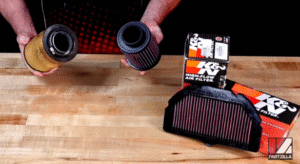
If you’re a woodworker, fabricator, or maker, you’ve likely relied on a CNC router to bring your designs to life. But have you ever wondered how thick of a material you can cut with your trusty router? You may be looking to tackle a new project that requires cutting through dense hardwood, thick plastics, or even metal. Or you may be curious about the limits of your machine’s capabilities.
Understanding your CNC routing‘s cutting capacity is crucial for ensuring accurate cuts and preventing damage to your machine. This guide explains everything you need to know about the thickness a CNC router can cut.
How Thick Can a CNC Router Cut?
The cutting thickness of a CNC router largely depends on several factors. Here are some of these factors:
Material Type
Most CNC routers can cut wood in numerous passes, depending on the machine’s power and the bit used. Hobbyist CNC routers can cut 1 to 2 inches of wood, although industrial-grade machines can handle 3 inches or more with numerous passes. CNC routers, like wood, can cut through plastics such as acrylic, polycarbonate, or PVC that are 1 to 2 inches thick in a single pass. Multiple passes might produce thicker slices.
CNC routers are not normally designed to cut metals, though some higher-end or specialized versions may cut softer metals such as aluminum. Metal has a substantially lesser depth per pass, often only 0.01 to 0.125 inches, due to its tougher substance and the necessity for precise, controlled cuts.
Router Power
Industrial routers with more power (e.g., 3 HP or more) can cut through thicker materials more effectively than hobbyist machines (usually less than 2 HP).
Bit/Tool
Longer bits can reach deeper but may need more stability and precision. Spirals or straight bits of sufficient length are commonly employed for thicker cuts.
Machine Rigidity
The stiffness of a CNC router determines its capacity to make deep cuts. A more robust machine resists vibrations and deflections, ensuring that the cutting tool remains steady and holds its position.
CNC Router Overview
A CNC router is a computerized machine used for milling, drilling, and cutting materials. It is similar to a milling machine, with some capable of performing almost the same tasks. The main functions are cutting, engraving, and carving objects out of a workpiece. CNC routers are essentially a replacement for the usual hand-held router. Introducing computer control to the process drastically reduces the number of errors.
CNC routers have different build volumes and configurations. They can work with one or more axes and swap tools to complete various tasks. The main feature of these machines is the computer control, which moves, rotates, and spins tools in accordance with a CAM program, which can be written manually for simple jobs or automatically using software. The program converts a digital CAD file into instructions for the machine to follow.
Different Materials Compatible with CNC Router
The success of a CNC project is dependent on selecting the appropriate material. This section looks at the various materials that are suitable for CNC routing, each with its own set of features and applications:
Woods
Wood’s inherent beauty and workability are popular with CNC amateurs and experts. CNC routers can sculpt, carve, and engrave wood with incredible precision, bringing raw timber to life. Hardwoods such as oak, maple, and walnut are valued for their durability and unique grain patterns, making them great for furniture and décor. Softwoods such as pine and cedar are softer and better suited to carving detailed motifs with less tool wear. Plywood and MDF (Medium Density Fibreboard) provide a solid and homogenous material for precision parts and templates.
The cutting capability of a CNC router varies by machine, but most can handle wood up to 3 inches thick. Advanced models, outfitted with powerful spindles and specialized cutting tools, can handle even thicker slabs, providing versatility for various jobs.
Plastics
Plastics’ versatility and strength make them a preferred material for CNC routing. From prototypes to finished goods, the possibilities are almost endless. Acrylic shines with clarity and flawless finish, making it ideal for signs and ornamental items. PVC (Polyvinyl Chloride) is a long-lasting and chemically resistant material for industrial applications. ABS (Acrylonitrile Butadiene Styrene) is well-known for its durability, making it ideal for functional parts and enclosures.
Composites
Composites like carbon fiber and fiberglass offer superior strength and lightweight properties over traditional materials. Due to their great performance, they are commonly used in aeronautical, automotive, and athletic goods.
Polymer Foams
Foams and modeling materials are essential for creating prototypes, architectural models, and theatrical props. CNC routers can easily shape materials like EVA foam and urethane, enabling the rapid production and iteration of designs. Polymer foams are suitable for CNC routing and offer the advantage of leaving no visible wear on the end while also allowing complicated shapes to be manufactured for custom packaging, aesthetics, test geometry, or low-risk practice. The low shear strength of these materials makes them easy to cut.
Non-Ferrous Metals
CNC routers may also process nonferrous metals, extending their applications beyond wood and plastics. Aluminum is lightweight yet strong, making it suitable for pieces that require a balance between the two. Brass and copper have distinct aesthetic appeal and are widely utilized in decorative arts and electrical components.
Other Materials
CNC routing’s versatility extends to many materials, each with unique benefits: Rubber is suitable for gaskets and seals due to its flexibility and toughness. Cork is chosen for its natural texture and sustainability; it is ideal for bulletin boards and coasters. Corian and other solid surfaces offer a long-lasting and non-porous choice for countertops and outdoor applications. Ceramic tiles are suitable for custom inlays and decorative flooring that require precise and delicate cuts. Stone and marble refine architectural features and personalized gifts but require specialized CNC routers for stone.
Key Considerations of Choosing a CNC Router for Cut
Here are the essential things to note before choosing CNC routers for your cuts:
Assessing Your Manufacturing Needs
Before making purchases from CNC router shop, they should fully assess your manufacturing requirements to ensure that the machine is aligned with your business goals and provides optimal performance and efficiency.
- Material Compatibility Consider the materials you’ll work with (acrylic, copper, brass, PVC, foam, MDF, solid wood, fiberglass, etc.). Your CNC router must be adaptable enough to handle the materials you plan to cut.
- Production Volume and Precision: Consider your company’s production needs and the level of precision required for your items. This will help you decide the CNC router’s toughness and accuracy criteria.
Understanding CNC Router Technologies
Understanding the technology behind CNC routers can help you choose the finest machine for your needs.
- Drive System Types: The drive system, which includes Rack and Pinion, Lead Screw, and Ballscrew options, has a direct impact on the machine’s precision, ability to handle greater material sizes, and maintenance costs over its useful life.
- Motor System Options: The choice between Servo Motors and Stepper Motors influences the router’s speed and precision. Servo motors are best suited for high-speed, high-torque applications, whereas stepper motors are more cost-effective for lower-speed activities.
Key Components of CNC Routers
Certain components are essential to the router’s operation and directly impact its cutting quality and capabilities.
- Spindle Characteristics: The spindle’s RPM, torque, power needs, and collet type are all important aspects to consider. They determine the cutting ability and compatibility with various equipment and materials.
- The importance of ATC: An Automatic Tool-Changing System is essential for activities that require many tools. It improves efficiency, decreases operator error, and shortens job times, making it necessary for complex projects.
Evaluating Machine Size and Construction
When purchasing a CNC router, its physical size and build must be considered, not just for workplace suitability but also for operational performance and longevity.
- Table Size Considerations: Ensure the CNC router’s table can handle your common material sizes. A larger table provides greater versatility for future projects and larger materials.
- Build and Weight: A heavier machine often indicates higher build quality and stability, which is essential for high-precision cutting. Consider the logistics if you need to relocate the machine frequently.
Software and Vacuum System Necessities
The correct CNC software and vacuum system may greatly affect the efficiency and cleanliness of your CNC cutting processes.
- Software Capabilities: Advanced software that provides accuracy, efficiency, and compatibility with complicated designs is essential. It should give regular updates and support for specialized production operations.
- Vacuum Holddown and Dust Collection: A strong Hoover hold-down mechanism assures material stability when cutting. However, an efficient dust collection system keeps the workspace clean and preserves the machine’s components.
Is There Any Other Way to Replace CNC Router Cut
Here’s a look at possible alternatives for your cutting needs instead of a CNC router:
Laser Cutters
They use a high-powered laser beam to cut or engrave materials. They are ideal for precision cutting, especially in thin materials like wood, acrylic, paper, and textiles. Unlike CNC routers, laser cutters can produce intricate designs with clean edges, making them perfect for decorative work and detailed patterns. However, they are generally less effective on thicker materials, and the heat from the laser can cause some materials to charge or melt.
Waterjet Cutters
Waterjet cutting is a highly versatile process that uses a high-pressure stream of water, sometimes with an abrasive material, to cut through almost any material. This technique is excellent for cutting metals, stone, glass, and composites without generating heat, which can alter the material’s properties. Waterjet cutters can handle thicker materials than CNC routers and produce smooth edges. However, they are usually more expensive to operate and maintain, and the process can be slower, especially for very thick materials.
Plasma Cutters
Plasma cutting involves using a jet of ionized gas (plasma) to cut electrically conductive materials like aluminum, steel, stainless steel, brass, and copper. Plasma cutters are fast and efficient, especially for cutting thick metal sheets. They are commonly used in industrial settings for metal fabrication. Unlike CNC routers, plasma cutters quickly cut through dense, tough metals. However, they are unsuitable for non-conductive materials and can produce rougher edges than other cutting methods.
Milling Machines
Milling machines are another alternative, particularly when working with metals. They remove materials from the workpiece using rotary cutters, and they can perform a wide range of operations like cutting, drilling, and boring. Milling machines can achieve high precision and are suitable for creating complex shapes in metal, wood, and plastic. They are similar to CNC routers but are typically more robust and capable of cutting thicker and harder materials. The trade-off is that milling machines are generally slower and more expensive.
Conclusion
The thickness that a CNC router can cut depends on various factors. They include the machine’s power, bit quality, and material density. Understanding these limitations and optimizing your machining process can open new creative possibilities and take your projects to the next level. Whether you’re working with wood, plastics, or metal, knowing the cutting capacity of your CNC router is essential for achieving accurate cuts, preventing damage, and pushing the boundaries of what’s possible. Always consult your machine’s documentation, test your limits, and innovate confidently.”





